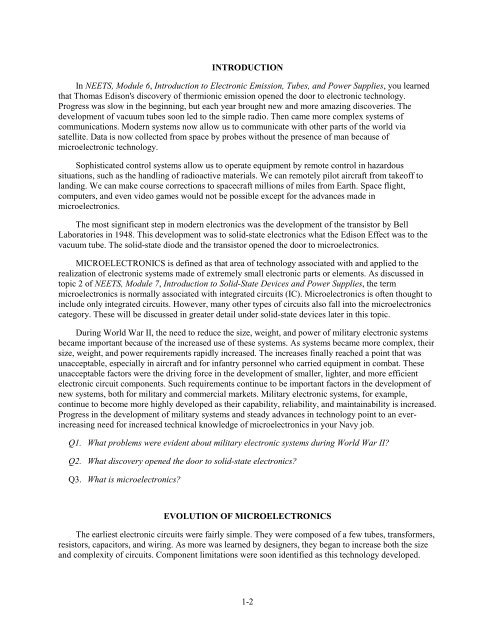Navy Electricity and Electronics Training Series - Historic Naval ...
Navy Electricity and Electronics Training Series - Historic Naval ...
Navy Electricity and Electronics Training Series - Historic Naval ...
You also want an ePaper? Increase the reach of your titles
YUMPU automatically turns print PDFs into web optimized ePapers that Google loves.
INTRODUCTIONIn NEETS, Module 6, Introduction to Electronic Emission, Tubes, <strong>and</strong> Power Supplies, you learnedthat Thomas Edison's discovery of thermionic emission opened the door to electronic technology.Progress was slow in the beginning, but each year brought new <strong>and</strong> more amazing discoveries. Thedevelopment of vacuum tubes soon led to the simple radio. Then came more complex systems ofcommunications. Modern systems now allow us to communicate with other parts of the world viasatellite. Data is now collected from space by probes without the presence of man because ofmicroelectronic technology.Sophisticated control systems allow us to operate equipment by remote control in hazardoussituations, such as the h<strong>and</strong>ling of radioactive materials. We can remotely pilot aircraft from takeoff tol<strong>and</strong>ing. We can make course corrections to spacecraft millions of miles from Earth. Space flight,computers, <strong>and</strong> even video games would not be possible except for the advances made inmicroelectronics.The most significant step in modern electronics was the development of the transistor by BellLaboratories in 1948. This development was to solid-state electronics what the Edison Effect was to thevacuum tube. The solid-state diode <strong>and</strong> the transistor opened the door to microelectronics.MICROELECTRONICS is defined as that area of technology associated with <strong>and</strong> applied to therealization of electronic systems made of extremely small electronic parts or elements. As discussed intopic 2 of NEETS, Module 7, Introduction to Solid-State Devices <strong>and</strong> Power Supplies, the termmicroelectronics is normally associated with integrated circuits (IC). Microelectronics is often thought toinclude only integrated circuits. However, many other types of circuits also fall into the microelectronicscategory. These will be discussed in greater detail under solid-state devices later in this topic.During World War II, the need to reduce the size, weight, <strong>and</strong> power of military electronic systemsbecame important because of the increased use of these systems. As systems became more complex, theirsize, weight, <strong>and</strong> power requirements rapidly increased. The increases finally reached a point that wasunacceptable, especially in aircraft <strong>and</strong> for infantry personnel who carried equipment in combat. Theseunacceptable factors were the driving force in the development of smaller, lighter, <strong>and</strong> more efficientelectronic circuit components. Such requirements continue to be important factors in the development ofnew systems, both for military <strong>and</strong> commercial markets. Military electronic systems, for example,continue to become more highly developed as their capability, reliability, <strong>and</strong> maintainability is increased.Progress in the development of military systems <strong>and</strong> steady advances in technology point to an everincreasingneed for increased technical knowledge of microelectronics in your <strong>Navy</strong> job.Q1. What problems were evident about military electronic systems during World War II?Q2. What discovery opened the door to solid-state electronics?Q3. What is microelectronics?EVOLUTION OF MICROELECTRONICSThe earliest electronic circuits were fairly simple. They were composed of a few tubes, transformers,resistors, capacitors, <strong>and</strong> wiring. As more was learned by designers, they began to increase both the size<strong>and</strong> complexity of circuits. Component limitations were soon identified as this technology developed.1-2

















